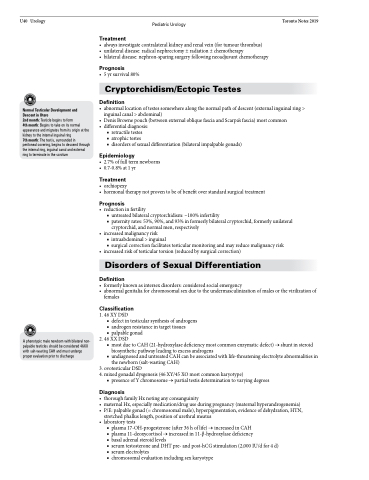Page 1358 - TNFlipTest
P. 1358
U40 Urology
Pediatric Urology
Toronto Notes 2019
Normal Testicular Development and Descent in Utero
2nd month: Testicle begins to form
4th month: Begins to take on its normal appearance and migrates from its origin at the kidney to the internal inguinal ring
7th month: The testis, surrounded in peritoneal covering, begins to descend through the internal ring, inguinal canal and external ring to terminate in the scrotum
Treatment
• alwaysinvestigatecontralateralkidneyandrenalvein(fortumourthrombus)
• unilateraldisease:radicalnephrectomy±radiation±chemotherapy
• bilateraldisease:nephron-sparingsurgeryfollowingneoadjuvantchemotherapy
Prognosis
• 5yrsurvival80%
Cryptorchidism/Ectopic Testes
Definition
• abnormallocationoftestessomewherealongthenormalpathofdescent(externalinguinalring> inguinal canal > abdominal)
• Denis Browne pouch (between external oblique fascia and Scarpa’s fascia) most common • differentialdiagnosis:
■ retractile testes
■ atrophic testes
■ disorders of sexual differentiation (bilateral impalpable gonads)
Epidemiology
• 2.7%offulltermnewborns • 0.7-0.8%at1yr
Treatment
• orchiopexy
• hormonaltherapynotproventobeofbenefitoverstandardsurgicaltreatment
Prognosis
• reductioninfertility
■ untreated bilateral cryptorchidism: ~100% infertility
■ paternity rates: 53%, 90%, and 93% in formerly bilateral cryptorchid, formerly unilateral
cryptorchid, and normal men, respectively • increasedmalignancyrisk
■ intraabdominal > inguinal
■ surgical correction facilitates testicular monitoring and may reduce malignancy risk • increasedriskoftesticulartorsion(reducedbysurgicalcorrection)
Disorders of Sexual Differentiation
Definition
• formerlyknownasintersexdisorders:consideredsocialemergency
• abnormalgenitaliaforchromosomalsexduetotheundermasculinizationofmalesorthevirilizationof
females
Classification
1. 46 XY DSD
■ defect in testicular synthesis of androgens ■ androgen resistance in target tissues
■ palpable gonad
2. 46 XX DSD
■ most due to CAH (21-hydroxylase deficiency most common enzymatic defect) → shunt in steroid
biosynthetic pathway leading to excess androgens
■ undiagnosed and untreated CAH can be associated with life-threatening electrolyte abnormalities in
the newborn (salt-wasting CAH) 3. ovotesticular DSD
4. mixed gonadal dysgenesis (46 XY/45 XO most common karyotype)
■ presence of Y chromosome → partial testis determination to varying degrees
Diagnosis
• thoroughfamilyHxnotinganyconsanguinity
• maternalHx,especiallymedication/druguseduringpregnancy(maternalhyperandrogenemia) • P/E:palpablegonad(=chromosomalmale),hyperpigmentation,evidenceofdehydration,HTN,
stretched phallus length, position of urethral meatus • laboratorytests
■ plasma 17-OH-progesterone (after 36 h of life) → increased in CAH
■ plasma 11-deoxycortisol → increased in 11-β-hydroxylase deficiency
■ basal adrenal steroid levels
■ serum testosterone and DHT pre- and post-hCG stimulation (2,000 IU/d for 4 d) ■ serumelectrolytes
■ chromosomal evaluation including sex karyotype
A phenotypic male newborn with bilateral non- palpable testicles should be considered 46XX with salt-wasting CAH and must undergo proper evaluation prior to discharge


